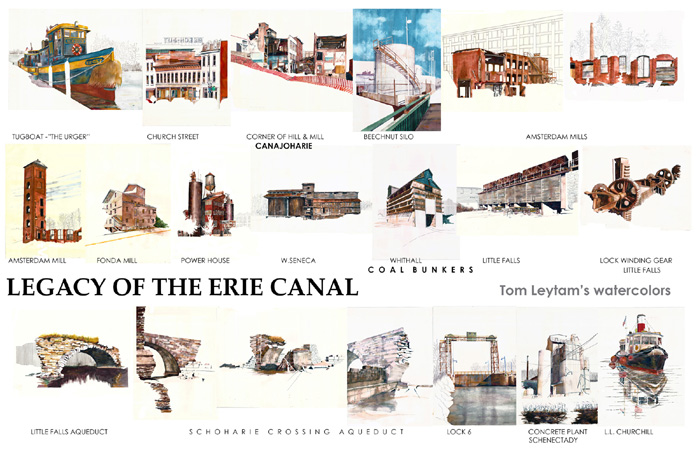Friends of Hudson Valley Ruins will be interested in this exhibit of watercolors by artist and architect Tom Leytham, which chronicles ruins along the Erie Canal. We’ve been a fan of Tom’s work, often focused on ruins and old industrial structures in Vermont, for a long time and we are excited to see his paintings of New York State ruins.
______________________
Tom Leytham: The Legacy of the Erie Canal – The Arkell Museum, Canajoharie, NY
Tom Leytham’s watercolor paintings of hand-built structures along the Erie Canal and Mohawk River Valley depict overlooked or forgotten sites of the manufacturing age. Tom is a registered architect whose work has been exhibited at the Vermont Governor’s Gallery, Bennington Museum, and Southern Vermont Arts Center and included in many publications.

(Click here for full version of image)
2017 is the 200th anniversary of the beginning of construction of the Erie Canal – America’s first super highway. It opened the western United States for trade and settlement. A hand dug ditch – 4’-0” x 8’-0”, 365 miles through the wildness was started in 1817 with pick, shovel and horses. It became a part of a network of canals unifying the northeast.
During the 200 years, technology and invention has changed the canal and the Mohawk Valley. The original can al was beside the Mohawk River because the technology to control the river was primitive. Now the river has been controlled and the canal has become the New York State Barge Canal. The remnants of the Erie Canal have become the route for the adjacent railroad lines and the New York Thruway is in the bed of the canal.
The development along the canal flourished in the 19th and into the middle of the 20th century. This trade route grew industry along its banks but much of the industry has moved on. Many historic and inventive structures remain – hiding in plain sight. The remains of the aqueducts and locks remain as a memorial to the vision of a few developers and politicians. Originally called Clinton’s Ditch by the nay sayers – it made New York the “Empire State.”
On display through August 16
The Arkell Museum
2 Erie Blvd, Canajoharie, NY 13317
Open March – December
Tuesday through Friday: 10:00 AM – 5:00 PM
Saturday and Sunday: noon – 5:00 PM
Closed Monday
http://www.arkellmuseum.org
“Things reveal themselves passing away”. William Butler Yeats
Since 2004, Tom Leytham has been documenting remnants of 19th and 20th century industrial buildings in the northeast–from New Brunswick to Vermont to the Hudson River Valley. He is fascinated by this architecture of necessity and invention; many of the sites show the evolution of the structures to accommodate the needs of the manufacturers and the land. Despite their massiveness, these unadorned structures also have a hand built character and speak of a time when craftsmanship and resourcefulness were basic values.
These are places of entropic beauty. Some of the buildings have been restored, some repurposed and some are being consumed by the landscape, but usually these former local landmarks are “hiding in plain sight”.
Just as the ruins in their incompleteness invite visual exploration, through the use of partial views, negative space, dramatic perspectives, and rich textures, I seek to create complex, pictorial environments that will engage the viewer’s imagination and focus attention on elements of detail and construction. The duality of density and emptiness—a motif of my work—lends an air of mystery and elegy to the landscape images.

What beautiful water colors. I love the old buildings in various upstate NY towns both old mills or quarries or otherwise. I like Amsterdam NY and Canajoharie, NY. It’s a bit far from NYC but I sure hope I can make it up to this exhibit before December. Upstate NY is in my heart and my son’s middle name is Hudson after the Hudson River and valley! Great post Rob.